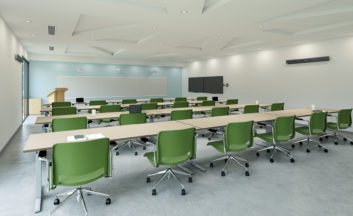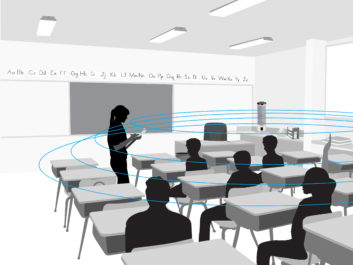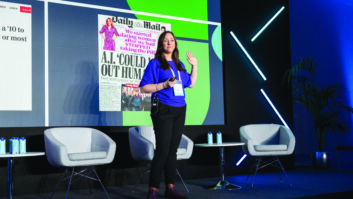Back in the mists of time – or at least the 1970s – the main audio visual (AV) event in most schools was when the big TV in its wooden box on top of a tall metal stand was wheeled into the classroom by a bored-looking man in a graph-paper shirt and corduroy tie. The most obvious deployment of sound equipment at that time was in the language lab, when pupils got to wear headsets with boom microphones (and most ended up pretending to be pilots until the teacher overheard them).
Things became more sophisticated as music departments got their own recording gear and, increasingly, proper studios. But sound for the classroom and, in higher education (HE), lecture theatres, has also evolved considerably in recent years, to the point where it is now an integral part of the learning process. As Ed Fairfield, commercial manager of specialist education AV reseller Elementary Technology, points out, although audio might be undervalued compared to visual/image-based media, teachers more often than not ask their pupils to listen.
WIDER FIELD
Audio for education is part of the wider field of EdTech, which research consultancy Futuresource noted in a recent report “has been a growing industry for years.” Initially, it continues, this technology was adopted as a way to “prepare students to work in increasingly digitised environments” but soon progressed to “driving productivity”, for both staff and pupils, and “creating a more personalised learning experience.”
![]() Associated with this, Futuresource’s Professional Audio in Higher Education – A Future in Hybrid Learning research, published in April this year, shows that universities view having a strategy for sound as a key consideration. This involves not only investment in equipment for lecture facilities but also awareness that the full audio chain, from microphones, recording equipment and sound reinforcement systems to DSP and audio over IP (AoIP) networks.
Associated with this, Futuresource’s Professional Audio in Higher Education – A Future in Hybrid Learning research, published in April this year, shows that universities view having a strategy for sound as a key consideration. This involves not only investment in equipment for lecture facilities but also awareness that the full audio chain, from microphones, recording equipment and sound reinforcement systems to DSP and audio over IP (AoIP) networks.
The pro audio report further highlights a growing demand in HE for innovations such as beamforming microphones. These are used as “high quality, contact-free, flexible audio devices” for picking up speech by presenters and audience members anywhere in a room. Several audio companies now offer their take on this concept. Among them is Sennheiser, which produces the TeamConnect Ceiling 2 microphone with automatic beamforming technology.
Sennheiser’s involvement in the education market focuses mainly on HE. Inesh Patel, business development manager for business communication at Sennheiser UK, comments that while smaller schools and colleges may have difficulties with budgets for this kind of equipment, HE institutions “are able to put quality above budget requirements or at least allocate budgets a bit better”. Patel adds that universities and others in this end of the market do see audio as a priority, not just for auditoria but also for a variety of teaching environments.
Before beamforming microphones, wireless mic technology was an important tool for the learning process and remains so today. Patel observes that the earlier forms of radio mics freed lecturers and teachers from cabled and fixed lectern equivalents. “Previously it was mainly UHF RF wireless mics, where you’d need to buy a licence to use it,” he says. “And if you were repeating the installation over multiple rooms you were looking at multiple licences, not to mention cross-frequency interference and having to replace all those batteries. Now there’s DECT [Digital Enhanced Cordless Technology], which is licence free and the basis of our range for speech and lectures, SpeechLine. This product also has monitoring capability, which allows the AV team to check battery levels and whether the mics have gone out of range over a large campus.”
Education is a very broad area, encompassing different age groups each with differing requirements and – in harsh economic terms – dramatically varying budgets available to spend on the technology that is now central to teaching. Nancy Knowlton, chief executive of audio conferencing developer Nureva, identifies a number of categories, including: large lecture halls in universities where the primary focus is on picking up the lecturer’s voice and amplifying it for in-room students and those participating remotely; smaller rooms in colleges and universities requiring a higher level of interactivity, including the need to amplify students’ voices as well as that of the lecturer; and primary and secondary classrooms with an increasing proportion of remote attendance by pupils but where the priority is amplifying the teacher.
“There are clearly exceptions to those generalities,” Knowlton comments. “A recent requirement that has emerged is in-room voice amplification at the same time students are connected to the classroom from other locations. This means more functionality from the same system, not multiple systems. Audio is foundational in many modern classrooms and has moved from a niche application in a lab to something that needs to be available everywhere at all levels of education, whether it is for in-room voice amplification or to connect remote students to a college or university classroom.”
SECONDARY ROLE
Audio visual technology has long had a presence in education but, as Ed Fairfield at Elementary Technology confirms, the ‘A’ in AV usually played a secondary role to the ‘V’. “Audio is the missing part of AV,” he says, “and schools tended to neglect it.” The situation has now changed and Fairfield comments that there is now more awareness of the part sound can play in teaching. “We encourage schools to buy a soundbar with touch screens. In the past audio was often behind a screen and playing to the wall, so it wasn’t very effective. Now it is facing forward and is more effective.”
 While AV continues to see audio paired with visuals, the partnership is more equal these days. This is particularly true for a widely used tool in EdTech, the visualiser. The modern successor to the overhead projector (OHP) is used both in the classroom, where objects or documents can be viewed through the integral camera and shown on a screen, or in videos and conference calls. The last two applications especially has called for visualisers to work in conjunction with microphones, so the teacher can explain the images.
While AV continues to see audio paired with visuals, the partnership is more equal these days. This is particularly true for a widely used tool in EdTech, the visualiser. The modern successor to the overhead projector (OHP) is used both in the classroom, where objects or documents can be viewed through the integral camera and shown on a screen, or in videos and conference calls. The last two applications especially has called for visualisers to work in conjunction with microphones, so the teacher can explain the images.
Elementary Technology handles the AVerVision brand of what the manufacturer describes as ‘document cameras’. Fairfield comments that audio is now very much a part of visualisers like this: “It is being used with them more than ever, both for synchronous learning, where someone is teaching live to pupils either in a classroom or remotely, and for asynchronous learning, where a presentation is prepared in advance.”
Another critical use of sound, which Fairfield calls a “hot topic and big priority”, is to provide inclusivity during lessons, enabling everyone – especially those with hearing difficulties – to hear what is going on. Among the systems being used for this is the FrontRow Juno, comprising a line array tower loudspeaker and a pendant microphone, which is worn by the teacher. The system has Bluetooth connectivity, enabling other audio material, such as music or speech clips, to be streamed and played out.
Matthew Farrer, the market development manager at QSC in the UK with responsibility for HE, acknowledges “video was the pathway to audio” in the education sector but that sound’s importance as part of an overall presentation has now been recognised. “With flat panel displays people no longer want to just play the sound from the screen, they are looking at either column loudspeakers either side or a distributed system, often with ceiling speakers,” he says.
In lecture theatres and classrooms, voice reinforcement systems are used to amplify or at least give a ‘lift’ to the speech of lecturers and teachers. Farrer says that “in most applications” the choice would be column loudspeakers, usually because of the size of the rooms involved. But, he explains, because of the increased use of hybrid and distance learning during the Covid-19 pandemic, distributed audio systems integrated with video are now more common. “End-users are now looking at dual ‘near and far’ situations. That means delivering good quality audio in the classroom but also bringing in the remote participants, who need to hear and see everything as well. We have PTZ [pan tilt zoom] cameras that operate with a platform like Q-SYS, which also controls the loudspeakers, amps and other audio inputs.”
Farrer adds that ceiling speakers are deployed in such scenarios to distribute the sound, while contactless microphones, which again can be mounted in ceilings, pick up the voices of the teacher/lecturer and students in the classroom or lecture theatre. This kind of technology became imperative during the coronavirus crisis to reduce the risk of infection, something that could be high if the previous method of passing a handheld mic from person to person was still employed. Systems that can be used for this include Sennheiser’s TeamConnect Ceiling 2, the Nureva Microphone Mist virtual system, EPOS EXPAND SP 30T speakerphone, Audio-Technica’s ES954 multi-element hanging mic and the beyerdynamic MPR 210 array.
INTEGRATED SOLUTIONS
The beyer microphone range is distributed in the UK by POLAR, which has an Integrated Solutions division that installs systems into HE establishments, including universities. Peter Curtis, business development manager for HE, observes that ceiling speakers and ceiling or drop-down mics “keep people in their seats” and also mean levels can be kept low. “What people are looking for is ease of use, simplicity and quality,” he says. “What has changed post-Covid is that there is more audio and microphone deployment is more widespread. We’re also seeing audio being transmitted around, with more interactivity.”
 In addition to this, Curtis says the pandemic has “emphasised a need for high quality audio” when it comes to voice enhancement in teaching scenarios. “Audio still goes hand in hand with video but if the students can hear as well as see [the lecturer or presentation], then they get the full benefit of the lesson,” he says. “High quality audio is essential, with voice lift to help the sound, but it’s not just about the loudspeakers it’s also about the room environment and acoustics.” POLAR supplies Primacoustic’s panelling and other treatments, which are installed in lecture venues to create more suitable acoustics and, in some cases, reduce the number of loudspeakers and microphones needed.
In addition to this, Curtis says the pandemic has “emphasised a need for high quality audio” when it comes to voice enhancement in teaching scenarios. “Audio still goes hand in hand with video but if the students can hear as well as see [the lecturer or presentation], then they get the full benefit of the lesson,” he says. “High quality audio is essential, with voice lift to help the sound, but it’s not just about the loudspeakers it’s also about the room environment and acoustics.” POLAR supplies Primacoustic’s panelling and other treatments, which are installed in lecture venues to create more suitable acoustics and, in some cases, reduce the number of loudspeakers and microphones needed.
The production and reproduction of good quality sound, plus appropriate reverberation times to suite the type of classroom, is important for audibility and intelligibility. But, according to a white paper by EPOS and research and consulting firm Frost & Sullivan published in November 2020, it can also help improve the general well being of pupils and students. The paper outlines that the move to online learning due to the pandemic involved “long hours of online classes” with students having to “focus harder to process non-verbal cues”, such as facial expressions, body language and the tone and pitch of someone’s voice. On top of this, it says, “poor audio can be a further drain on students’ emotional and mental well being.”
Poor sound due to delays caused by bad internet connections, many people speaking at the same time or background noise can result in someone feeling stressed, which has a negative impact on their health. The researchers concluded: “Learning in the classroom, physical or virtual, in the presence of noise is more difficult than ever. Students learning from their homes or dorm rooms with noisy backgrounds or in cafés or classrooms with surrounding chitchat, struggle to concentrate and get tired easily. The result — students lose their focus, motivation and cognitive processing.”
To deal with these negative aspects of online or hybrid learning, the white paper recommends improving the audio quality through the use of active noise cancelling headsets, which are able to tune out background noise and produce clear sound. Such headsets, it continues, should be ergonomically designed, lightweight and comfortable, especially if students are going to be wearing them for prolonged periods.
Logan Helps, distributed brands manager at Audio-Technica, comments that “the expectations of good audio have increased significantly in recent years”, with the days of cheap microphones going into an underpowered PA in the assembly hall now left behind. “We’re finding that schools and colleges are paying attention to every aspect of audio delivery, from address systems in communal areas to the way in which sound for online lessons is provided,” he says. “Audio solutions often need to be unobtrusive, easy to use and in keeping with increasingly well designed education spaces. This means low profile speakers and well-designed user interfaces are important.”
Helps highlights how audio can assist in creating better learning environments with the example of an installation for students with ADHD (attention deficit and hyperactivity disorder), who find external sounds extremely distracting. “Even when the teacher spoke directly with one student, it would distract the other students,” he says. “We helped design and implement an audio system with headphones for the students and a simple to operate communication matrix for the teacher to speak to an individual student, a table of students or the whole class.”
COMMONPLACE AUDIO
As in other areas of audio, networking is, according to Helps, “becoming more commonplace in education situations”. Simpler installations based on CAT5 cabling and a central switcher or console such as A-T’s ATDM-0604 Digital SmartMixer can bring both logistical and budgetary benefits. Helps points out that these installations deliver flexibility to configure systems using software and link rooms within the facility. “It allows buildings to become multi-use and cater for changing class needs or online delivery with minimum disruption,” he says.
![]() AV over IP (AVoIP) and AoIP technologies have made this much simpler to implement and execute. On the AoIP side, Audinate, developer of the Dante protocol, has seen an increase in both the use of this technology and the creation of networked facilities within schools, colleges and universities. “The ability to link multiple rooms on campus, multiple rooms on different campuses and remote learners via video conferencing is the main change we have seen as a result of the global pandemic,” comments Brad Price, senior product marketing manager at Audinate. “Ensuring your AVoIP system integrates easily and effectively with common video conferencing tools is important. But, as we return to our physical spaces, we need a solution that provides a true hybrid environment: on-site, remote and all combinations in between.”
AV over IP (AVoIP) and AoIP technologies have made this much simpler to implement and execute. On the AoIP side, Audinate, developer of the Dante protocol, has seen an increase in both the use of this technology and the creation of networked facilities within schools, colleges and universities. “The ability to link multiple rooms on campus, multiple rooms on different campuses and remote learners via video conferencing is the main change we have seen as a result of the global pandemic,” comments Brad Price, senior product marketing manager at Audinate. “Ensuring your AVoIP system integrates easily and effectively with common video conferencing tools is important. But, as we return to our physical spaces, we need a solution that provides a true hybrid environment: on-site, remote and all combinations in between.”
Price observes that there has been “a lot of innovation” over the last 18 months, with AoIP being used to link between the different uses and configurations within a classroom or lecture theatre – and beyond. “Educators are using Dante systems to speak to in-class participants through a local PA, have their audio streamed to overflow rooms and be on video conferencing tools in real-time,” he says. “This combination of uses is likely to stay in use moving forward and it’s exciting to think about how that will enable more individuals to join classrooms no matter where they are in the world.”
The Futuresource Professional Audio in Higher Education – A Future in Hybrid Learning report confirms this, stating that “increases in the number of AoIP-enabled devices now available has also provided significant opportunities for institutions looking to upgrade to a comprehensive and fully connected network”. It also states that, since the outbreak of Covid-19, HE has become “an even more important market” for professional audio brands.
Which shows that sound has finally graduated from the juniors to the higher realms of AV.







